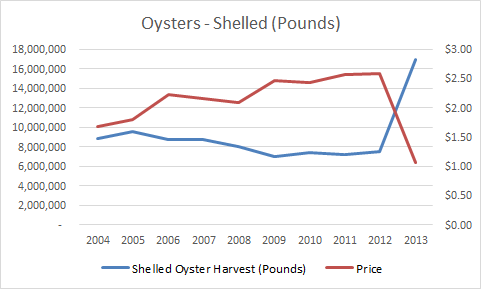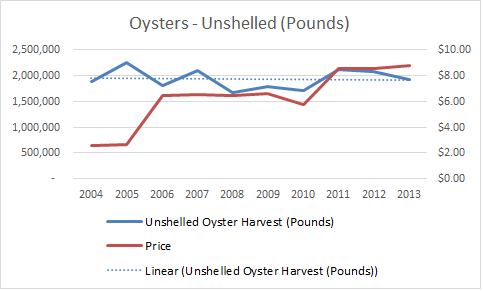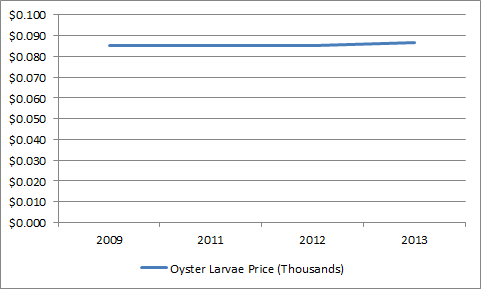Relevant Topics
Last year was a banner year for oyster aquaculture in Washington state waters.
According to data from the Washington State Department of Fish and Wildlife, the harvest of shelled oysters rose dramatically last year, more than double the amount from 2012, and 78 percent higher than the previous high in 2005.
 Harvest of unshelled oysters didn't see that kind of increase, but matched the level that has been consistent over the past decade.
Harvest of unshelled oysters didn't see that kind of increase, but matched the level that has been consistent over the past decade.
In 2013, Washington oyster growers harvested 1.9 million pounds as reported to Fish and Wildlife, a level higher than five of the last ten years. The trend line for oyster harvests during that time is almost perfectly flat.
 These numbers back up the statements of Department of Ecology scientists who argue there is no evidence that ocean acidification is causing oyster deaths in Washington state waters.
These numbers back up the statements of Department of Ecology scientists who argue there is no evidence that ocean acidification is causing oyster deaths in Washington state waters.
The data stand in stark contrast, however, to claims made by the Governor, the Ecology Director and others who claim that we are "already seeing" oyster deaths due to ocean acidification.
For example, the Governor has repeatedly noted that the acidity of the ocean has increased by 30 percent in recent decades. This, however, amounts to three percent of potential daily change in ocean acidity measured in Washington state waters.
Data on the price of oysters and oyster larvae back up the harvest data, signaling they are representative of larger trends.
Since 2006, when there was a big jump in unshelled oyster prices, the price of oysters has increased about four percent per year. Of course, oysters are in a national market, so prices may also reflect national events. The jump from 2010 to 2011 coincides with the Gulf oil spill which may have reduced nationwide supply of oysters, driving prices up.
The relationship between price and harvest is even clearer with shelled oysters. Prices rose gradually about six percent per year, until 2013 when they collapsed to the lowest level in a decade. This trend mirrors the massive increase in supply of shelled oysters.
The price data are extremely useful when assessing claims about oyster deaths.
First, as noted above, they tend to back up the harvest data. If the price and harvest data were out of sync it would indicate problems with the harvest data. There will be some who claim the harvest data provided by Fish and Wildlife are incomplete or inaccurate. The fact that prices and harvest levels tend to follow each other, especially in the case of the spike in 2013 unshelled oyster harvest, undermines this claim.
It could also be claimed that harvests have remained consistent thanks to the work of oyster harvesters who have figured out how to deal with acidification. In other words, acidification is occurring, even if it isn't appearing in the data.
 This could be true and it would be a testament the power of people in a free market to adapt and innovate, a message we highlight all the time.
This could be true and it would be a testament the power of people in a free market to adapt and innovate, a message we highlight all the time.
The price data for oyster larvae, however, undermine the claim that acidification is causing difficulty for oyster growers.
If acidification was causing increased mortality among oyster larvae, we would expect the price to be rising. Data are only available for the period from 2009-2013, but the price of larvae increased only two percent over the course of those four years. The fact that prices are steady indicates the economic impact of acidification on oyster larvae is small or zero.
Some have highlighted individual anecdotes of larvae death they claim is due to acidification. The plural of anecdote, however, is not data and recent trends in larvae prices do not back up those claims.
Despite taking center stage in the discussion about climate change, claims about oyster deaths have been remarkably data free, relying on anecdotes or unverified testimony. The data from Fish and Wildlife are publicly available and easy to obtain but, unfortunately, have not been used during the debate.
This is a problem for taxpayers and the environment. Every dollar spent addressing non-issues, is a dollar lost to the many real environmental (not to mention educational and other budgetary) issues faced by Washington state. Bad science - or simply ignoring science - can only lead to the waste of precious resources.




